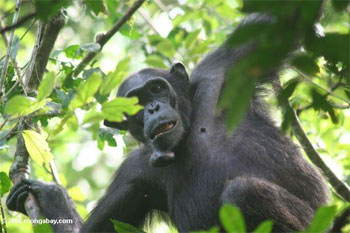Predators prefer to eat stupid animals
Predators prefer to eat stupid animals
mongabay.com
August 2, 2006
Predators such as jaguar and chimpanzees consistently target smaller-brained prey less capable of escape according to research published in the Royal Society Journal Biology Letters.
The study, carried out by Dr Susanne Shultz, from the School of Biological Sciences at the University of Liverpool, found that predators avoid more intelligent prey such as monkeys which have exceptionally large brains and are more capable of escaping attacks.

Wild chimpanzee in Uganda. Photo by Rhett A. Butler
|
Dr Shultz looked at predators including the jaguar, chimpanzee, leopard and puma, and found a “strong correlation between the brain size of the prey and the predatory bias towards it.” Dr Shultz said that small-brained animals lack “behavioral flexibility” and “are probably less capable of developing new strategies to escape predators, compared with larger-brained species.”
“When these findings are put into perspective, it makes sense that being clever should help individuals avoid or escape danger — the larger-brained chimpanzees rarely feature in the diets of predators,” Dr Shultz remarked. “Some animals’ ability to avoid being eaten by predators may be a contributing factor to the evolution of large brains across some species, adding to conventional theories which argue this is important for developing social relationships and using tools.”
RELATED ARTICLE
Orangutans and chimps are smarter than monkeys and lemurs
Researchers at Duke University Medical Center found that orangutans and chimpanzees consistently outperformed monkeys and lemurs on a variety of intelligence tests, conclusively proving that apes are more intelligent than monkeys and prosimians. Scientists have long observed that some species perform better than others in intelligence testing but they have had difficulty proving that these differences could be attributed to intelligence. Now researchers have found proof of comparable mental capacity in primates.
This article is a modified news release from the University of Liverpool.














